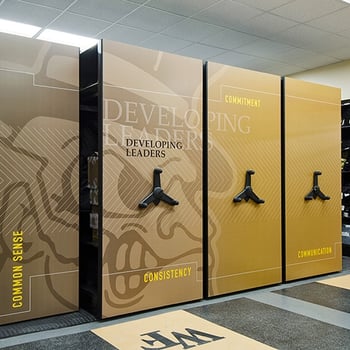When man first invented the wheel, there were probably some accidents. Things were suddenly moving, and that meant a big adjustment for cave people. Or think about how the introduction of the automobile threw people into a tizzy. When we started to move storage, that also raised questions about mobile shelving safety features. Here’s help.
Doug Kreager has been selling mobile storage to clients since 1978. He’s fielded the “how do I know people won’t get hurt?” question many times. It makes sense, he said. “Providing a safe working environment should be part of every discussion we have with a prospective client because it can have a major influence on how the buying decision is made.”
So, we asked Doug about mobile shelving safety features. He’s seen many changes in the mechanical and electric systems for high-density mobile storage. The controls have become more advanced for electrical systems, and mechanical sweeps, safety floors, and infrared lights are used for added protection too.
The Positives of Passive Protection
Spacesaver has long been a leader in developing safety features that offer “passive” protection for the end-user. We don’t always think of passive as being a good thing, but in this case, it means users don’t have to actively ensure safe operation of the mobile shelving.
The evolution began in electrical systems with the safety floor designed to activate when a user stepped into an aisle. A user might not know someone was already in another aisle or that an object had been left out in an open aisle. Moving the shelving rows could prove disastrous to people or the stuff being stored. The safety floor recognized weight over 25 pounds in an aisle and prevented shelf movement when a human or object occupied an aisle.
To let users activate their shelving systems without having to check all existing open aisles for obstacles, the system even had a fail-safe feature. If the floor malfunctioned, wires were damaged or a sensor became inoperative, the system would not operate — just as if someone or something was in the aisle. The system could only be operated without the safety floor in effect with a managerial override key, which sounded an alert that the system was being used.
The safety sweep was the next passive protection feature developed. If someone operating a powered or mechanical-assist mobile shelving unit started to move the carriages, anyone in the aisle could step on the floor-level safety sweep to apply the brakes. Activated by minimal pressure, the safety sweep halts carriage movement quickly and safely.
Even a fallen object pressing against the sweep would be enough to stop the aisle movement. The handle of the mechanical shelving unit is then locked, and the affected aisle needs to be cleared and reset using the override key. For the powered shelving, when the path is broken or interrupted, the system then is shut down and an operator must identify in which aisle that occurred and back the carriage away to clear the aisle.
Adding Safety with Technological Advances
The primary safety feature for mechanically assisted systems used to be the “push/pull pin.” This was designed to lock off the handles on either side of an aisle that was in use to protect against accidental movement. Yet this feature’s reliability was totally dependent on the user engaging and disengaging the pins after every operation.
Advancing technology moved storage safety forward. Infrared eye Photo Sweeps or Zero Force Sensor (ZFS) systems replaced the Safety floor and Safety Sweep in many cases.
With today’s Photo Sweep for powered shelving systems, an infrared light beam is projected the length of the carriage base. If a foot or object obstructs the constantly projected beam of light, system movement stops.

The difference between the photo sweeps and safety sweep is the technology used. The mechanical sweep is designed to operate based on an object applying pressure against the sweep plate that then engages a brake and is located along the length of the carriage. The photo sweep uses an infra-red beam that shines down the length of the carriage and when broken or blocked triggers the system to stop. An example would be garage doors when the beam is blocked the door will stop coming down. That builds confidence in the idea that the photo sweep will protect users when they are in the aisle.
In an environment with heavy traffic for the powered mobile shelving, aisle entry sensors also make sense. The invisible infrared beam, unaffected by sunlight or ambient light extremes, is mounted roughly waist-high between the carriages. Entering an open aisle — or trying to scoot into a closing one — breaks the beam and prevents system movement.
ZFS systems rely on many infrared beams projected across the full length of the open carriage. Once any of the beams is broken, the system automatically locks down the carriage movement — without any effort on the part of the user. Both Photo and ZFS solutions automatically reset after the user exits the aisle.
The current safety features offerings have been in place since the early 2000s with some operational improvements and features added to meet the customer’s needs. Nevertheless, the main idea that protection should be passive has remained.
Moving Forward with Mobile Storage
Mobile storage systems are now common. High-density mobile shelving boosts efficiency, improves workflow and increases success in libraries, hospitals, athletic equipment rooms, museums, police departments and other environments.
Doug has seen customers’ comfort level with mobile shelving increase. “Their fear of being caught in the system has decreased,” he said.
 This has led to people making decisions about mobile shelving safety and operations based on budget. The desire for purchasing added safety features has waned. However, while some of our competitors are downplaying the need for safety features to sell more mechanical-assist systems, we recommend weighing the pros and cons of both powered and mechanical-assist solutions.
This has led to people making decisions about mobile shelving safety and operations based on budget. The desire for purchasing added safety features has waned. However, while some of our competitors are downplaying the need for safety features to sell more mechanical-assist systems, we recommend weighing the pros and cons of both powered and mechanical-assist solutions.
A customer “needs analysis” is a great place to start. You’ll especially want to weigh whether the system will be accessed by the general public or restricted to trained personnel when selecting the best type of storage and its safety features.
Safety is a top priority whether the storage is mobile or not. But when it comes to powered and mechanical-assist mobile storage, customers can rest assured that passive protections are in place to ensure security and reliability.
Learn more today about your high-density mobile storage options. Contact a Patterson Pope expert today!












